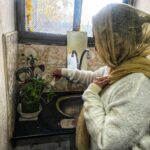Every morning, 55-year-old Khadija unlocks the door to a modest workshop tucked inside her neighborhood. Inside, the rhythmic whir of sewing machines blends with quiet conversation as dozens of women bend over delicate embroidery, weaving traditional Kandahari scarves and stitching Afghan dresses. For many of them, this is more than a workplace; it is their only escape from hunger and despair.
“Most of the women here are widows or orphans,” Khadija explains as she supervises her workers. “They have no one else to rely on. If this center closes, their children will starve.”
What Khadija has built is remarkable — not only because it employs 60 vulnerable women, but because it survives at all in today’s Afghanistan.
Since the Taliban seized power in August 2021, Afghan women have been systematically erased from public life. They are banned from universities and most secondary schools. They cannot work for NGOs, visit parks or gyms, or even travel without a male guardian. Women-run businesses and markets have been shuttered in many provinces, cutting off thousands from their livelihoods.
Against this suffocating backdrop, Khadija’s workshop stands as a rare sanctuary.

A Center Born From Struggle
A decade ago, Khadija started small, sewing scarves in her living room and selling them to neighbors. With years of savings — hundreds of thousands of Afghanis — and later with support from the Norwegian Refugee Council (NRC), she expanded into a modest production center. Today, 60 women embroider, sew, and weave in shifts, producing hand-crafted goods that are sold in Kandahar, Kabul, and Herat provinces.
“We make men’s shawls, Kandahari scarves, Afghan dresses. Almost everything is hand-stitched,” Khadija says. “But our biggest challenge now is finding markets. If we had stable places to sell our work, these women could stand on their own feet.”

Voices From the Workshop
For many of the women here, the workshop is their only chance to provide for their families.
Bibi Hawa, a widow with three young children, remembers how she struggled before joining:
“I used to clean people’s homes for bread. Now I earn from sewing and embroidery. If we had more support, we could send our children to school and feed them properly.”
Mohsafa, another worker, says her husband is too old and sick to work.
“Two of my children had to leave school because I couldn’t afford the fees. This workshop is all I have left. I pray that the government or charities create women-only markets so we can sell our products.”
Mah Bibi, paying rent on a small home, echoes the plea:
“This work saved us. But prices are going up every day. We need buyers for our crafts so we don’t lose this lifeline.”

A Rare Beacon in Troubled Times
Kandahar’s hand-embroidered textiles and traditional designs have long been prized across Afghanistan. But years of war, economic collapse, and the Taliban’s edicts restricting women’s mobility have eroded demand. Humanitarian agencies warn that initiatives like Khadija’s are vital to prevent destitution among Afghan women, particularly as international aid dwindles.
“Women’s economic participation in Afghanistan is at its lowest point in decades,” a Kabul-based development expert told the Afghan Time. “Supporting grassroots businesses like this is one of the few ways left to get cash directly into women’s hands.”

A Call for Action
Khadija dreams of expanding her center and creating women-only bazaars where her artisans can sell without fear of harassment or interference.
“This isn’t just a workplace,” she says. “It’s a sanctuary. It’s where women learn skills, earn dignity, and keep their children alive. If we lose this, they lose everything.”
In Pictures
Photographs: The Afghan Times







































